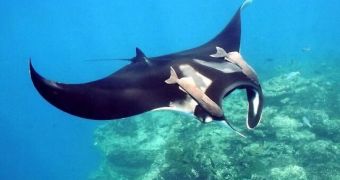As is the case with sharks, manta rays are worth more when left to roam the ocean and not killed for the sole purpose of collecting their body parts and then selling them.
These past few years, manta rays have been increasingly tracked down and killed by fishermen.
Conservationists say that this is because numerous people in East Asia believe that these animals' gill plates (i.e. branchial filaments) have medicinal properties and are therefore eager to buy them.
Those who use these animal body parts for medicinal purpose say that they can treat and even cure conditions ranging from asthma to chicken pox and even cancer.
Ironically enough, the very same people who buy and use manta gill plates admit that this form of treatment more often than not fails to impress, and that they do have other options at their disposal.
“While the meat of these animals is deemed to be of poor quality and is worth little the gill plates or branchial filaments have become highly sought after in Asian markets where they are utilized in a tonic marketed to treat a wide variety of conditions,” reads a study recently published in the journal PLOS ONE.
“Some practitioners even admit that gill plates are not effective and that many other alternatives are available,” a NGO said, as cited by Mongabay.
Said study draws attention to the fact that, financially speaking, it makes more sense to protect these animals rather than hunt them down.
“As an example in Indonesia, revenue to fishermen from manta gill plates is estimated at roughly $400,000 (€307,069), while manta tourism brings in over $15 million (€11.51 million) in revenue to communities that can continue year after year without depleting manta populations,” study lead author Mary O’Malley stated in a recent press release.
The researchers estimate that the ecotourism set up around these marine creatures in 23 different countries around the world is worth $140 million (€107.47 million) per year.
On the other hand, the gill plate trade is only worth about $5 million (€3.83) per year.

 14 DAY TRIAL //
14 DAY TRIAL //